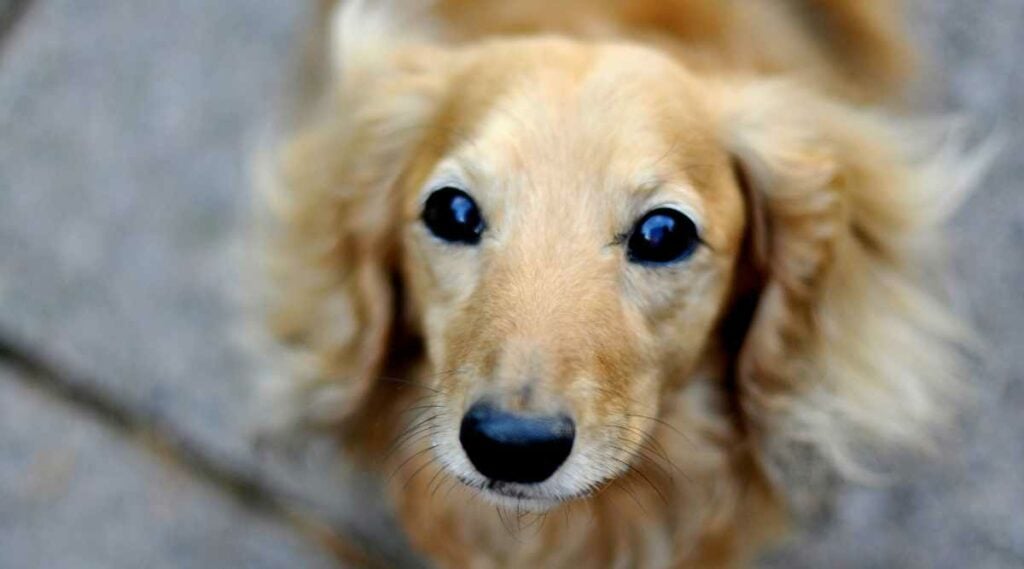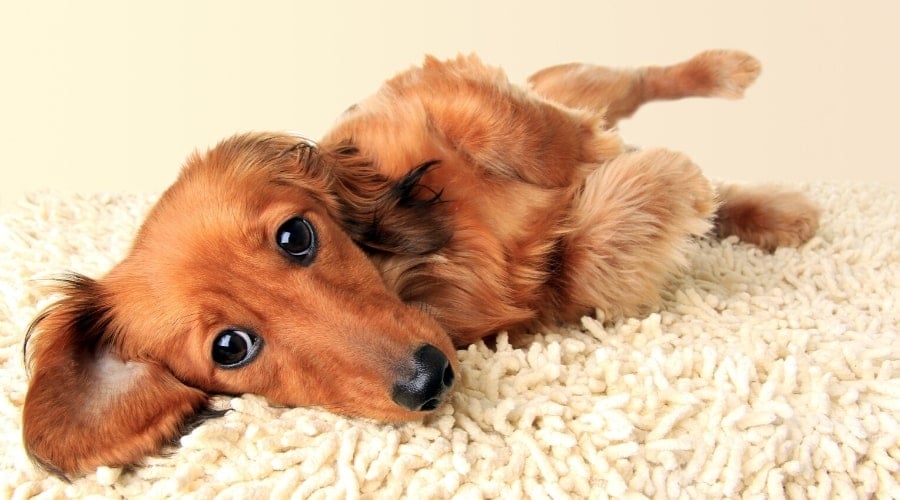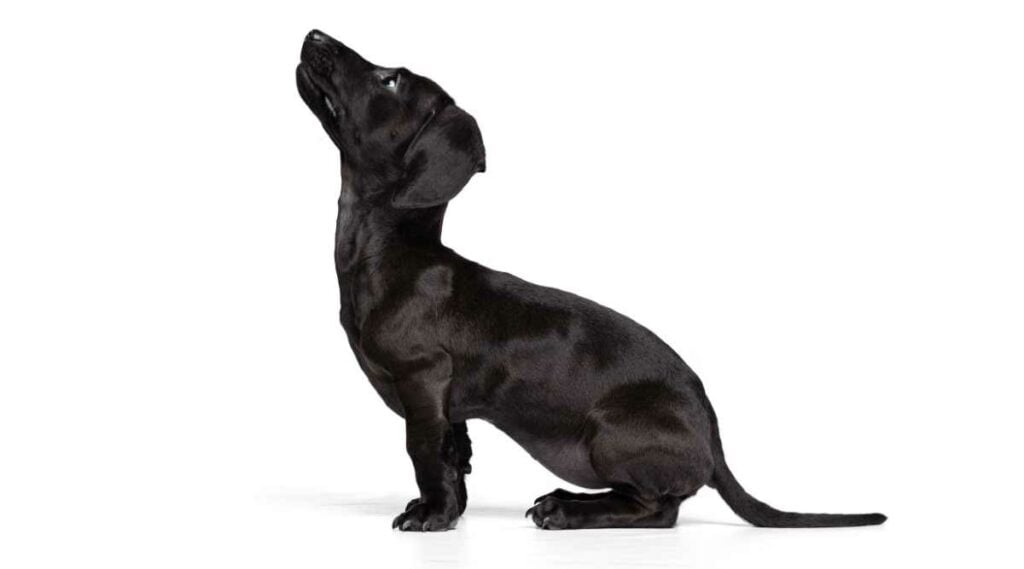Dachshund Colors: 15 Standard & Non-Standard Variations
When you purchase through links on our site, we may earn a commission. Here’s how it works.
Dachshunds are one of the most iconic dog breeds in the world. Their long body, little legs, floppy ears, and human-like eyes make them a super cute breed. Dachshunds are curious, friendly, and spunky and have a lot of doggy personality packed into their tiny frame. Their cuteness and fun character are one of the reasons why they are popular dog breeds across the world.
Table of Contents
Another reason why they are so popular is that they have an incredible range of coat types, colors, and markings. Some breeds only have a few colors, but with the Dachshund, there are so many to choose from. There are 15 standard and non-standard coat colors. These are Black and Tan, Chocolate and Tan, Cream, Wheaten, Wild Boar, Red, Blue and Tan, Fawn and Tan, Black and Cream, Fawn and Cream, Chocolate and Cream, Blue and Cream, Black, Chocolate, and Fawn. There are also five marking types that affect their coat colors, which are Brindle, Dapple, Piebald, Sable, and Brindle Piebald.
Some colors are more common than others, and specific colors are more common in different coat types. We explain all this and frequently asked questions about how their coat color affects their health, personality, and more. Whether you’re researching which color Dachshund you should pick or trying to identify which color Dachshund you have, you’ve come to the right place. So, without further ado, let’s look at all the exciting Dachshund coat colors and patterns.
Dachshund Genetics & Health
The world of doggy color genetics is complex and confusing. In a nutshell, two pigments determine the color of all dog coats, and they are eumelanin and pheomelanin. Eumelanin produces dark colors such as black and brown, and pheomelanin causes the amount of yellow and red in a coat. The pigments in a Dachshund’s coat depend on the color genes they inherit from their parents. Dachshunds can also inherit other genes that determine whether their coat has different markings.
Dogs can inherit a standard color gene, or they might inherit a dilute gene. The dilute gene essentially dilutes the color, making it a different color altogether. Dachshunds born with the dilute gene have an increased risk of color dilution alopecia (CDA), which can affect a dog with any blue, fawn, or other dilute coloration. One of the markings in this breed, dapple, is similar to merle in appearance and associated health problems.
Standard Dachshund Colors
There are many different kennel clubs worldwide, and each one has a breed standard that lists the ideal characteristics of that breed. The primary kennel club in America is the American Kennel Club (AKC.) The AKC’s Dachshund breed standard details coats and what colors they accept in the show ring. Reputable breeders usually bred Dachshunds with these colors, making them more common than non-standard colors. But some of these colors are rarer than others. Let’s take a closer look at each one.
Black & Tan
Black and tan is the most common Dachshund coat color and the color most people think of. Their coat is predominately black with tan markings. These tan markings appear on their eyebrows, muzzle, forechest, and legs. The tan markings on this coat type are distinctive because they stand out from the black base color.
Chocolate & Tan

Chocolate and tan Dachshunds are the next most common coat color. They have a deep brown chocolate coat with the typical tan markings on their eyebrows, muzzle, forechest, and legs. The tan markings aren’t as striking as black and tan Dachshunds because the base color and markings are both shades of brown.
Cream

Cream Dachshunds sport a cream to golden color all over. Some creams have black hairs on their ears and tails, and some refer to these dogs as “shaded creams.” They are sometimes confused with creams with the sable pattern. But unlike sable hairs that are light at the root and darken towards the tip, their hairs are entirely black from root to tip. There are two types of cream Dachshunds: American and English. However, they both fall under the same color category. Let’s take a look at how they differ.
American Cream
American creams are the most common in America, and they get their blonde coat from a combination of the red and dilute blue gene. They are born light in color, and their jacket takes on a cream-to-pale red shade as they age. American creams can come in any coat type or body variety. Some American creams have dark features like eye rims, noses, and paw pads. But some also have lighter color features.
English Cream
English creams get their blonde coat from the chinchilla gene, and they are born dark and lighten as they age. Genuine English cream Daschunds only come in miniature long-haired varieties and should always have dark features. English creams are very rare and descend from a handful of breeders in the United Kingdom, with only a few true English cream American breeders. Any breeder selling English creams should provide you with the papers to prove their heritage. English creams are much more expensive than American creams.
Wheaten
Wheaten Dachshunds have a light golden coat with brown and white hairs throughout, giving them a wheat color. This is a rare Dachshund color mainly seen in wire-haired Doxies, although the color is seen in short and long-haired varieties more. Wheatens are sometimes mistaken for creams, but wheaten-colored pups are slightly darker.
Wild Boar
Wild Boar color Doxies have a mix of silver to dark gray-brownish hair, very similar to a boar’s coat. Some individual hairs have different color bands on them. This is a rare coat color and is most common in wire-haired varieties. Like many other two-toned Doxies, most wild boar Dachshunds have lighter color markings around their eyebrows, muzzle, forechest, and legs.
Red

Red Dachshunds typically have a rusty brown to red color coat all over, although some of them have a yellow tinge. They are sometimes confused with chocolate coats, but the color is more red than brown. Some red-coated Dachshunds have black hairs on their ears and tails, and these pups are sometimes referred to as “shaded reds.” Shaded reds are sometimes confused with red coats with sable markings, but the black hairs on their ears and tail are entirely black rather than two-toned.
Blue & Tan
Blue and tan Doxies are rare. They are similar to black and tan Dachshunds, except they have inherited the dilute color gene. Essentially, this dilute gene dilutes the black color, making it gray, known as blue in some dog breeds. Usually, the tan markings appear on the eyebrows, muzzle, forechest, and legs. The dilute gene also dilutes the color of their features, making them more gray. A blue color Doxie has an increased risk of CDA.
Fawn (Isabella) & Tan
Fawn is essentially a diluted chocolate color, and in some dog breeds, it is also known as “Isabella.” So, like the blue and tan pups, these dogs are chocolate and tan colored Doxies except with the dilute gene. The tan markings on the eyebrows, muzzle, forechest, and legs are sometimes difficult to see compared to the other colors, as the tan and fawn are close in shade. Their features are usually fawn rather than black, and they have an increased chance of inheriting CDA.
Black & Cream
Black and cream Doxies are similar in appearance to black and tan pups, except the tan markings are much lighter in color. The markings on their eyebrows, muzzle, forechest, and legs are more cream than tan. These are rarer than black and tan colors.
Fawn (Isabella) & Cream
Fawn and cream Doxies are the same as fawn and tans, except their markings are much lighter in color. These Doxies have the dilute color gene, which means they have an increased risk of CDA. These colors are rare.
Chocolate & Cream
Chocolate and cream Doxies are similar in appearance to chocolate and tans, except their markings are cream color, much lighter than the more common tan markings. These Doxies are rare.
Blue & Cream
Blue and cream Dachshunds are like black and cream pups, but the dilute gene means that their black coat is a much lighter blue-gray. Doxies with cream markings are much rarer than tan markings, and the dilute blue coat color is much rarer. Like any Doxie with the dilute gene, they are at risk of suffering from CDA.
Non-Standard Dachshund Colors
Several colors are seen in the Dachshund breed but are rare and not considered a standard color. Any pup with the following colors is not allowed in the show ring. Because they are disqualified from the ring, most breeders do not breed dogs in the following colors for this reason. However, they pop up in litters from time to time.
Black

Black Dachshunds have a solid black coat with no other colors or markings. It is very rare to find a solid black Doxie, and they are the most rare color out of all of them.
Chocolate
Chocolate Doxies have a solid chocolate coat with no markings or other colors present. The color is rich brown, like chocolate, rather than a reddy-tan or dilute color. Pure chocolate Doxies are very rare, although not as rare as a pure black pup.
Fawn
Fawn-colored Dachshunds have a solid fawn coat without any markings or other colors. Technically, they are chocolate Doxies, but with the dilute gene that makes their coat much lighter in color. Pure fawns are rarer than solid chocolates.
Dachshund Color Variation
If you come across any other color or pattern not mentioned in our Dachshund color guide, there is a considerable chance that they are not a purebred Doxie. Instead, they are probably a Doxie mix breed. But some irresponsible breeders might market them as a rare colored Doxie. If in doubt, ask to see their parents, papers, and health certificates to be sure you are getting a healthy, purebred Doxie.
There is debate about whether a pure white Dachshund exists. White is not mentioned in the breed standard as a recognized color. Most “white” Doxies are cream but very pale cream, making them appear white. These pups have dark features. If you come across a white-colored puppy, you must be sure they are not suffering from albinism. Albino dogs have no pigmentation and usually have pale blue eyes and a pink nose. Although they can make lovely pets, they often have multiple health conditions and behavioral concerns.
Dachshund Markings
There are many Dachshund coat colors to choose from, but there are also many Dachshund markings to consider. These different markings can appear on any coat color, and some Doxies have a mixture of various markings. This makes their coat variety mesmerizing. The first four markings are standard and acceptable in the show ring. Although the brindle piebald pattern is recognized, it is not a standard color. Let’s take a closer look at each Doxie marking.
Brindle
The brindle pattern is compared to the stripes on a tiger, and it is a beautiful pattern seen in many other breeds. They usually have a light brown or red base color, sometimes cream, with darker stripes on top. Doxies with the dilute gene have diluted stripes. Brindle Doxies are rare. It’s challenging to identify this pattern in long and wire-haired Dachshunds.
Dapple
The dapple pattern has mottled patches of color. In other breeds, this pattern is called merle. This pattern can occur on single or double-colored Doxies. Although dapples are rarer than non-dapples, they are becoming increasingly popular because of their striking appearance. They often have bright blue or different-colored eyes, which is called heterochromia. The dapple pattern can appear on any coat or body type.
Like merle dogs, dapples have an increased risk of health issues such as deafness and blindness. When buying any dog, working with a responsible dog breeder is important. But it’s crucial for dapple Dachshunds. Breeders should never breed two dapples together because inheriting a dapple gene from both parents can cause even more health problems. These pups are called double dapples. Regarding the dapple pattern, you must know about the parents and ask to see relevant health certificates.
Piebald
The piebald pattern has large patches of white on their body, which commonly appear on the head, back, legs, and tail. They can also have flecks or small spots of color on the white patches. It’s often compared to the typical Cocker Spaniel coat pattern. The piebald pattern can occur on a Doxie with any coat or body type. However, it’s much easier to identify this pattern in a shorthaired dog. Due to the large patches of white, especially around the head and ears, piebald Doxies should be tested for hearing problems.
Sable
The sable pattern describes when hairs are lighter at the root and darken towards the end. The sable pattern is rare but most commonly found on red or fawn-colored Doxies. Red and cream-shaded pups are often confused with sables but have a few concentrated dark hairs rather than black-tipped hairs.
Brindle Piebald
Brindle piebald is a recognized marking, but it is not a standard marking and, therefore, not accepted in the show ring. They typically have a brown or red base coat with dark color stripes and large white patches. The white patches are usually around their trunk, but if it’s on their head or ears, they need a hearing test. A brindle piebald Doxie is extremely rare.
Dachshund Coat Types & Colors
There are three Dachshund coat types, and these are smooth, long-haired, and wire-haired.
- Smooth Coat. The smooth coat is the most common coat type, and it is short, smooth, and shiny all over. Smooth coats come in all sorts of color coats and markings, and they are much easier to identify compared to long and wire-haired coats.
- Long-haired Coat. Long-haired Dachshunds have sleek, glistening, and slightly wavy hair. Their hair is longer around the neck, forechest, underside of the body, ears, and behind the legs. Long-haired Dachshunds have an elegant appearance. Like the smooth coat, they sport all the colors and markings listed above.
- Wire-haired Coat. A wire-haired coat is characterized by a tight, short, thick, rough, hard outer coat with a finer undercoat. The hair around the jaw and eyebrows is thicker and more pronounced, giving them a tough “grandad” appearance with a beard and thick eyebrows. The most common colors in a wire-haired Dachshund are wild boar, various shades of red, and black and tan. But they can come in any of the listed colors and markings. Tan points and other markings might not be as evident as those on a shorthaired pup.
Frequently Asked Questions

What Color Dachshund Sheds The Most?
The amount that Dachshunds shed is not related to their coat color but the type of coat they have. All Dachshunds are minimal to moderate shedders. Long-hairs shed the most noticeably, although they are seasonal shedders. Smooth coats shed minimally but throughout the year. And wire-hairs shed the least.
Does A Coat Color Affect A Dachshund’s Health?
Although the Doxie is a generally healthy dog breed, they are predisposed to a few health conditions, so you should consider pet insurance. A few of these health conditions are related to their coat color. Any Doxie with a dilute coat, such as blue or fawn, is more at risk of inheriting CDA. It’s not curable, but it is relatively simple to manage. Any Doxie sporting a coat with increased white patches, especially around the head and ears, is more at risk of deafness. The same goes for dapple Dachshunds, who have an increased chance of blindness and deafness.
Unfortunately, irresponsible breeders breed Dachshunds for color because they can make more money from “rare” colors. But breeding for color over health makes them even more likely to develop health problems. They often breed closely related dogs, too, which can increase congenital defects. Dachshunds are rife in puppy mills because they are popular dogs. So, please avoid irresponsible breeders and puppy mills at all costs. Only work with a responsible and ethical Doxie breeder.
What Color Dachshund Should I Get?
This depends on what color Doxie you like and your plan for your pup. If they are going to be a family pet, the color isn’t too important. Some families prefer the iconic black and tan smooth coats, whereas some like the rarer cream or fawn and cream. But if you plan on showing or breeding your Doxie, it’s wise to pick a standard-color pup.
Final Thoughts
The coat colors and patterns in the Dachshund breed are full of variety. From the iconic black and tan to the brindle or dapple patterns, there is a coat color and pattern to suit everyone’s tastes. They are all beautiful in their own way, and there is no better color. But it would be best if you were wary of a few coat colors and the increased risk of health problems they carry. But by working with a responsible breeder who subjects their dogs to health checks, you should receive a healthy and delightful Dachshund. And as a Doxie owner myself, there is never a dull day with a Doxie about!



